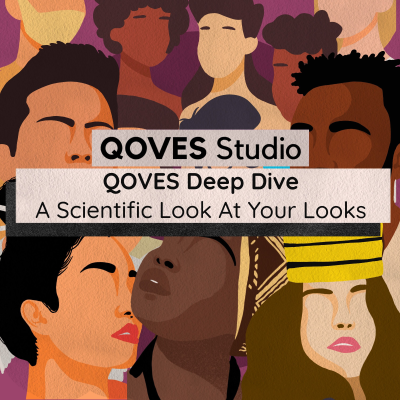
QOVES Deep Dive | A Scientific Look At Your Looks
Engels
Technologie en Wetenschap
Tijdelijke aanbieding
1 maand voor € 1
Daarna € 9,99 / maandElk moment opzegbaar.
- 20 uur luisterboeken / maand
- Podcasts die je alleen op Podimo hoort
- Gratis podcasts
Over QOVES Deep Dive | A Scientific Look At Your Looks
Have you ever noticed that attractive people are treated better by others? Maybe it's in the grocery store where they get to cut in line unsolicited, or at the work where two seemingly matched coworkers get passed up for a promotion for the newer, more attractive one. Physical appearances play a huge, pervasive role in your life, whether we care to admit it or not and in this show, we comb through the psychological and evolutionary scientific literature to give you answers on exactly how and why we are this way. If you're new to the world of facial aesthetics, visit the QOVES youtube channel for a more digestable introduction into beauty culture and anthropometric science! Exclusive & Latest episodes: https://www.patreon.com/qovesstudio https://www.youtube.com/c/QOVESStudio https://www.qoves.com/ https://www.tiktok.com/@qovesstudio
Alle afleveringen
14 afleveringenThe Struggles of Being Too Attractive | Would You Rather Be Attractive Or Unattractive?
Is there such thing as being too attractive? Apparently so, as we look at a thesis by Mehng on a unique case of Debrahlee Lorenzana who was fired for distracting workers by being 'too attractive.' However, the details of the case aren't as simple as they seem, and if Debrahlee was both attractive but also narcissistic in her personality, then that would make her seem extremely unlikeable, leading us to a theory where being attractive but having a poor personality, has more of a 'double effect' on a persons likeability than being regular in looks but with negative personality traits. * Timming, A.R., Baumann, C., & Gollan, P.J. (2021). Employee voice and perceived attractiveness: are less attractive employees ignored in the workplace? * When physical attractiveness does not benefit: Focusing on interpersonal relationship, target employee personality, and career success. Si Ahn Mehng University of North Carolina at Pembroke
Why Attractive Faces Are Not Average
This week, we look at the opposite of Ep.12 which suggests that averageing faces results in more attractive looking composites. Much of the benefits of averaged faces are that they have unusually higher rates of symmetry and perfectly clear skin (as a byproduct of the compositing process). However, as other researchers have found, averageness in your facial appeal only gets you so far, and to be truly unique and striking, your face needs features that deviate away from the average and into the extremes of dimorphism and proportion. * Langlois, Judith H.; Roggman, Lori A.; Musselman, Lisa (1994). WHAT IS AVERAGE AND WHAT IS NOT AVERAGE ABOUT ATTRACTIVE FACES?. Psychological Science, 5(4), 214–220. doi:10.1111/j.1467-9280.1994.tb00503.x * Alley, Thomas R.; Cunningham, Michael R. (1991). AVERAGED FACES ARE ATTRACTIVE, BUT VERY ATTRACTIVE FACES ARE NOT AVERAGE. , 2(2), 123–125. doi:10.1111/j.1467-9280.1991.tb00113.x
Why Averaged Faces Are Not Average | Koinophilia
When it comes to assessing facial attractiveness, 'Facial Attractiveness: Evolutionary Based Research ' by AC Little has proposed three tenants: Symmetry, Dimorphism and Averageness; it is the last point that is seldom discussed and even less understood. An averaged face is one produced as a composite of many other faces. If we were to get many faces, all of a similar ethnic or racial group and overlay their faces together, then the Averageness Hypothesis suggests that the produced face will be more attractive than the sum of its parts, i.e. more attractive than those faces by themselves. This is because averaged faces have greater symmetry and clearer skin, but then the real question to answer becomes is averageness (koinophilia) desired because it is attractive by itself or is it desired because it makes the faces more symmetric (is symmetry the real driving force for why we prefer averageness)? * Tim Valentine; Stephen Darling; Mary Donnelly (2004). Why are average faces attractive? The effect of view and averageness on the attractiveness of female faces. , 11(3), 482–487.
The Penalties Of Being Unattractive In Social Interactions
Being unattractive is a disadvantage in many social interactions if you do the wrong thing or act out of line. These unusual behaviours are called 'norm violations' and as it turns out, there is a double devil-effect at play when physically unattractive people behave in an unattractive way. The devil effect is the opposite of the more commonly known halo effect where negative cognitive biases are placed on a person based on their physical characteristics. As such, we expect an unattractive person committing norm violations such as making a potentially risque remark towards a woman in the workplace to be percieved as very repelling behaviour; a double devil effect. * Gibson, Jeremy L.; Gore, Jonathan S. (2015). You’re OK Until You Misbehave: How Norm Violations Magnify the Attractiveness Devil Effect. Gender Issues, 32(4), 266–278. doi:10.1007/s12147-015-9142-5
Beauty or Brains? What Is More Important For Partner Selection?
It's undeniable that intelligence is attractive, but the question still remains whether it is attractive enough to outweigh physical beauty. In this episode, we take a deep dive into the importance of physical attractiveness and what role it plays against other commonly praised traits such as intelligence and more importantly, how this affects men and women asymmetrically. * Egebark, J., Ekström, M., Plug, E., & van Praag, M. (2021). Brains or beauty? Causal evidence on the returns to education and attractiveness in the online dating market. Journal of Public Economics, 196, 104372.
Kies je abonnement
Tijdelijke aanbieding
Premium
20 uur aan luisterboeken
Podcasts die je alleen op Podimo hoort
Gratis podcasts
Elk moment opzegbaar
1 maand voor € 1
Daarna € 9,99 / maand
Premium Plus
Onbeperkt luisterboeken
Podcasts die je alleen op Podimo hoort
Gratis podcasts
Elk moment opzegbaar
Probeer 30 dagen gratis
Daarna € 11,99 / month
1 maand voor € 1. Daarna € 9,99 / maand. Elk moment opzegbaar.

































